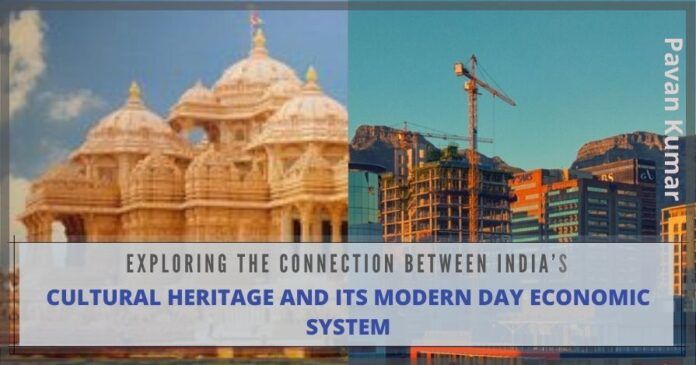
The previous part of the article can be accessed here. This is the second part.
A present-day likeness can be drawn to that of think tanks and internal data departments offering advice to governments and educating those in policy-making about issues and possible consequences of their actions.
A major takeaway from the Hindu culture is that the very equation of limited resources unlimited needs doesn’t have a counterpart in the Hindu economic system, primarily because, it asks people to forego material things, control their needs and share the excess to the needy and fellow citizens. This shows that not only free-market orientation existed but a socialistic pattern of living was also part of daily life!
The only difference being, in today’s world, the ‘Guru Dakshina’ or the guru’s due. is in terms of money rather than various actions or tasks.
Supplementing the above finding is that there are strong evidences, often passed on from grandparents to grandchildren, until the land-ceiling acts were brought in, of self-sustaining economic systems in villages. In the rural areas, the land-owners who employed tenants on their farms were given a share of the harvest and sometimes even treated as family and given one or two cattle. This is in line with a popular saying ‘Jan Seva hi Prabhu Seva’ meaning service to man is service to God. Even today, rural economy is characterised around cattle, traditional crops like rice, wheat, and jowar along with cotton and jute. What one cannot ignore is that in the traditional system of agriculture, the cow’s milk, yield and the Indian cow as a breed were held in high esteem and preserved throughout history. This was not because a cow was a part of religious documents and mythology but because of Indian cow milk’s high medicinal and economic benefits. Thus, it became a part of its culture and was carefully preserved. In today’s Indian rural scenario, the consequences of inter-breeding are coming to the fore where the hybrid cows are unable to give proper account of milk leaving farmers clueless as to how to produce more milk. The solution invariably lies in protecting and multiplying the original Bos indicus cow breed that is a part of our culture, which is why cultural festivals are carried out to showcase the local breeds. So, therefore, it is clear, that in India’s case, culture when seen from the perspective of economics, does catalyse its inherent economic engines and can help it recover its original economic prowess. Be it start-ups, entrepreneurship, and Gita, cows and Kamadhenu, comparative advantage and Arthashastra, culture continues to play a very vital role in retaining unique desi formulas for the development of the Indian economy instead of blindly incorporating foreign theories in the Indian model.
There is another factor that has helped in cultural-economic growth and can once again provide advice and momentum – Guru Shishya Parampara, which is an ages-old concept of knowledge between teachers and disciples or rather a system connecting those who knew and those who did not know. It still is in place in towns and mutts in the towns of religious significance like Shringeri in Karnataka, Kedarnath, Kanchi, etc., and has held an important place in Indian education in the past. For thousands of years, this system kept the Varna system in check and ensured that the freedom to carry out any economic activity would prevail by educating those engaging in them. I identify this as a major factor in spearheading the growth in Ancient India for the simple reason that all kings, princes and other occupations had a set of teachers or gurus who did not necessarily come from one particular varna, who would constantly teach them about things like importance of doing one’s duty, warfare, honest administration, taxes, importance of maintaining trade links so as to ensure that their kingdoms were in a mode of continuous growth. A present-day likeness can be drawn to that of think tanks and internal data departments offering advice to governments and educating those in policy-making about issues and possible consequences of their actions. The only difference being, in today’s world, the ‘Guru Dakshina’ or the guru’s due. is in terms of money rather than various actions or tasks.
This system also taught the children of that age to safeguard their traditions and culture and continue it so as to keep the identity intact and the community united. The outcome of such were Lachit Borphukan, Shivaji and the Rajputs in whose reigns, discrimination was banned and egalitarianism was the order of the day while continuing to establish links with foreign countries via sea routes, protecting the lands from external aggression and keeping up the growth of the provincial economics. Similar instances can be seen in the case of Kautilya and Chandragupta Maurya during the rule of the Mauryan Empire and Sri Krishnadevaraya and his minister Timmarusu, during the reign of the Vijayanagara Empire. One can go to Hampi in Karnataka and know about the local stories passed down through the families, talk about the existence of a booming economy and export of cotton to Java and the Far East.
Unpopulated Villages and Populated Cities
So, when it comes to how problems of present-day agricultural distress, agglomerisation and other aspects of $2 trillion worth economy of India can be addressed, heads of state and policymakers must take into consideration the role of local culture in shaping peoples’ mindsets, behavioral attitudes, and reaction to ideas which they can relate to. No person would be willing to take part in a government program if he doesn’t feel incentivized enough. Therefore cultural aspects have to be integrated into schemes to make people feel they are a part of it and therefore can contribute something to it. To transform a rural economy, it’s not enough to ensure farmers’ children are sent to school, it is equally important that they do not fully move away from that profession. What happens if the number of farmers comes down? Who will feed the country? How will people be urged to take up farming as a business? To ensure such a scenario does not arise, a rural economic system must be kept intact with its traditionalism and interest rates for farm loans need to be brought down, coupled with adequate policies for improving domestic market options.
Agglomerisation was seen even in ancient times when cities became centers of economic, religious and administrative importance. Gaya in Bihar, Tirupati in Andhra Pradesh, Somnath, and Dvaraka in Gujarat, Ayodhya, and Banaras in U.P, etc., were identified with their hosting of temples related to key deities and they had their own temple-town economies reliant on necessary requirements for temples and pilgrims (places to stay during visits, check-ups). But the kingdoms ensured the administrative setup did not function from there and similarly spread out the financial and manufacturing centers across the kingdom. This meant that one city could not be the main city and therefore several new cities came up, controlling the movement from rural areas to urban while at the same time giving each area its due recognition. So, similarly, the lesson to be drawn in the modern context from the past experience is that provinces or states need to develop all major towns equally while ensuring one city would be the chief administrative centre. This way, the haphazard urbanization that is seen today can be controlled. In this regard, creating ‘HERITAGE’ cities under ‘H.R.I.D.A.Y’ by G.o.I is a welcome move. The policy of balanced urban development and connecting rural areas while retaining their characteristic features assumes significance in the event of division of Andhra Pradesh into two states in 2014. It is heartening to note at the end of this article that the importance of sector-wise regional growth has been understood by N.Chandrababu Naidu, CM of Andhra and is charting out plans to develop each of the 13 districts in the state in different areas. This will go a long way in bringing out the districts uniqueness and hidden talent and create resources.
So, at the end of the day, it must be realised that :
1. India can grow only with the help of Indians because of – Entrepreneurship, free
exchange of ideas and flexibility in the environment.
2. Foreign investments are necessary but not sufficient. They are helpful to the extent
they bring in new technology. Domestic potential needs to be thoroughly exploited and
on a war footing, to channel investment into productive sectors and R&D and
innovation must be brought in.
3. Cultural heritage promotes risk-taking and fearlessness but needs to be further
encouraged amongst youth.
4. Acknowledgment of economic progress in the past and appreciation of cultural
heritage and its richness and success in creating egalitarian societies in India must be
made and showcased to our countrymen first and then abroad.
If the above points are considered by policymakers and leaders in whatever they do, I am sure, there will come a time soon when India will re-capture the pole position in the global economy.
Note:
1. The views expressed here are those of the author and do not necessarily represent or reflect the views of PGurus.
- Ancient to Modern : Exploring the connection between India’s cultural heritage and its modern day economic system. Part 1 - December 25, 2019
- Ancient to Modern: Exploring the connection between India’s cultural heritage and its modern day economic system. Part 2 - December 24, 2019
- Prioritizing Growth over Welfare Spending – A Kuznets U-curveApproach in the Indian Context - December 22, 2019











In Picture showing Akshardham. It self showing All Part 1&2 . And even more value. Akshardham is a best Example of Gurubhakti. See Ref.on http://WWW.Baps.Org OR Akshardham.Org.